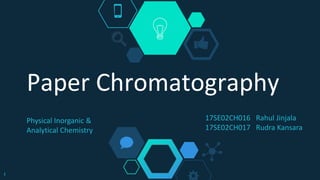
Chromatography01
- 1. Paper Chromatography 1 Physical Inorganic & Analytical Chemistry 17SE02CH016 Rahul Jinjala 17SE02CH017 Rudra Kansara
- 2. Content: 2 •What is Chromatography? •Classification Of Chromatography •Mechanism Of Separation •Planar Chromatography types •Paper Chromatography •Applications of paper Chromatography 2
- 3. Chromatography: 1 Chromatography is a technique for separating mixtures into their components in order to analyze, identify, purify, and/or quantify the mixture or components. 3
- 5. 5 1. Based on mechanism of separation • Adsorption chromatography • Partition chromatography 2. Based on phases I. Solid phase chromatography • Solid – liquid • Solid – gas II. Liquid phase chromatography • Liquid – liquid • Liquid – gas
- 6. 6 3. Based on chromatographic bed I. Planar chromatography • Paper • Thin layer II. Column chromatography • Packed column • Open tubular column
- 7. 7
- 8. “ 8 • Column Chromatography The stationary phase is held in a narrow tube through which the mobile phase is forced under pressure or by gravity. • Planar Chromatography The stationary phase is supported on a flat plate or the interstices of a paper and the mobile phase moves through the stationary phase by capillary action or by gravity.
- 10. “ 10 • Partitioning equilibrium (SP : liquid, MP : liquid/gas) • Adsorption equilibrium (SP : solid, MP : liquid) • Exclusion equilibrium (SP & MP : liquid) • Ion Exchange equilibrium (SP : solid ion – exchanger, MP : liquid electrolyte) • Affinity equilibrium (SP : immobilised ligand, MP : liquid)
- 12. “ 12 • Thin layer Chromatography (TLC) Separates dried liquid samples with a liquid solvent (mobile phase) and a glass plate covered with a thin layer of alumina or silica gel (stationary phase). • Paper Chromatography (PC) Separates dried liquid samples with a liquid solvent (mobile phase) and a paper strip (stationary phase).
- 14. Purpose: 14 • Use the technique of paper chromatography to separate a homogeneous mixture into its individual components Uses: • Separation • Identification Chromatographic paper: • Stationary phaseSolvent: • Mobile phase
- 15. 15 Capillary action The movement of liquid within the space of a material due to the forces of adhesion, cohesion, and surface tension. The liquid is able to move up the filter paper because its attraction to itself is stronger than the force of gravity. Solubility the degree to which a material (solute) dissolves into a solvent. Solutes dissolve into solvents that have similar properties (like dissolves like). This allows different solutes to be separated by different combinations of solvents. Separation of components depends on both their solubility in the mobile phase and their differential affinity to the mobile phase and the stationary phase.
- 16. Experiment: 1 • Preparation time : 10 minutes • Experiment time : 45 minutes Purpose: Time required: • To introduce the principle and terminology of chromatography. Costs: • Less than Rs 50. 16
- 17. Materials: • Beakers, cover lids • Distilled water • Isopropanol • Filter • And other stationary materials 17
- 18. Procedure: 1) Preparing isopropanol solutions: • Prepare 15 ml of the following isopropanol solutions in approximately labelled beakers: 0%, 20%, 50%, 70%, and 100% 2) Preparing the chromatography strips: • Cut 6 strips of filter paper. • Draw a line 1 cm above the bottom edge of the strip with the pencil. 18
- 19. • Label each strip with its corresponding solution • Place a spot from each pen on your starting line 3) Developing chromatograms: • Place the strips in the beaker • Make sure the solution does not come above your start line. • Keep the beakers covered • Let the strips develop until the ascending solution front is abut 2 cm from the top of the strip • Remove the strips and let them dry 19
- 20. 20
- 21. 21
- 22. Observation: 1) Observe how some of the dyes are made up of more than one colour 2) Observe how spots of the same colour separated in low concentrations of isopropanol compared to higher concentrations 3) Observe when spots of different colours first started separating in the different concentrations 22
- 23. 23 0% 20% 50% 70% 100%
- 25. “ 25 • Separation of amino acids: Mobile phase: butanol : acetic acid: water(4:1:1) Detection: spray with ninhydrin reagent • Separation of carbohydrates: Mobile phase: ethyl acetate : pyridine water(10:4:3) Detection: silver nitrate (1 ml in 200 ml of acetone). 40% NaOH in methanol gives brown spots.
- 26. References: 1) Physical Inorganic Chemistry 2) https://owlcation.com/stem/What-is-Paper-Chromatography-Principle-Uses- experiment-video 3) https://www.britannica.com/science/paper-chromatography 26